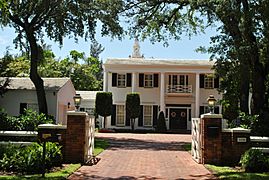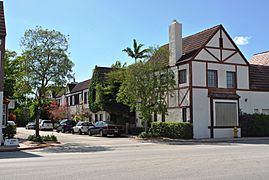Coral Gables Villages facts for kids
The Villages of Coral Gables are special neighborhoods in Coral Gables, Florida. They were designed by the city's founder, George E. Merrick. Each village has a unique international theme.
Contents
The Idea Behind the Villages
A City with Different Styles
When George E. Merrick planned the city of Coral Gables, Florida, he had a big idea. He wanted to create small communities, or "villages," within the city. Each village would have a different international style. This plan was called "The Village Project."
Most buildings in Coral Gables are in the Mediterranean Revival style. But Merrick wanted to add more variety. So, some villages, like the Chinese and Dutch South African ones, were designed to look very different.
Building the Villages
The villages were built during a time when land was booming in Florida in the 1920s. However, building stopped by the end of the decade. This was due to several big events. Two major hurricanes hit in 1926 and 1928. Then, the Great Depression started with the Wall Street Crash of 1929.
Because of these problems, fewer than 80 homes were finished out of the 1,000 Merrick had planned. Many villages were never built. These included Japanese, Italian Country, Mexican Hacienda, and Persian Canal villages. Merrick also dreamed of a large Spanish Village, but he couldn't finish it before he passed away.
A New Try: Old Spanish Village
Many years later, a developer named Ralph Sanchez tried to bring Merrick's Spanish Village idea to life. In the mid-2000s, he started the "Old Spanish Village" project. Sanchez was inspired by Merrick's original vision.
The new project was planned for downtown Coral Gables. It was designed in the classic Spanish Revival style. It included cobblestone walkways, balconies, and gardens. Sanchez wanted to keep the charm of Merrick's original villages.
He even worked to save a historic 1926 art center building. He spent a lot of money to fix it up. This was to connect the old history with the new project. A famous historian, Arva Moore Parks, also joined the team. She helped make sure the project honored Coral Gables' past.
The project started in 2007. But like Merrick's original plan, it faced problems. A worldwide economic slowdown, called the Great Recession, hit. Also, Ralph Sanchez passed away. The project was later renamed "Mediterranean Village." Eventually, a new company bought the land. They built a much larger, modern commercial area called "The Plaza Coral Gables."
Merrick's Lasting Impact
Arva Moore Parks once said that George Merrick believed "beauty was for everyone." He wanted to create beautiful places where people felt special, even if they weren't rich.
After the original Village Project stopped, its unique building styles inspired homes in Cincinnati from the 1930s to 1950s. The French Normandy Village was sold to the University of Miami in 1935. It later housed student groups. The other six historical villages that were completed are now known as "Landmark Homes" in Coral Gables.
It's good to know that the Village of Merrick Park, a shopping mall built in 2002, is not related to these historic themed villages.
The Existing Villages
Here are the villages that still exist today:
- Dutch South African Village: This village looks like Dutch farmhouses from the 1600s in South Africa.
* Architect: Marion Sims Wyeth. * Locations: 6612, 6700, 6704, 6710 LeJeune Road and 6705 San Vicente Street.
- Chinese Village: Inspired by Oriental buildings, all houses here are connected by a shared wall. This creates a unique compound.
* Architect: Henry Killam Murphy. * Built: 1926-1927. * Locations: Bounded by Sansovino Avenue, Castania Avenue, Maggiore Street, Riviera Drive, and Menendez Avenue.
- French Normandy Village: These homes look like village houses from 15th century France.
* Architects: John and Coulton Skinner. * Built: 1926-1927. * Locations: Bounded by LeJeune Road, Viscaya Court, Viscaya Avenue, and Alesio Avenue.
- Florida Pioneer Village/Colonial Village: This village is in the Georgian Colonial style. It was inspired by buildings in New England.
* Architects: John Pierson, and John and Coulton Skinner. * Built: 1925-1926. * Locations: 4320, 4409, 4515, 4520, and 4620 Santa Maria Street. This area is part of the Santa Maria Street Historic District since 2007.
- French Country Village: These houses look like country homes from 18th century France.
* Architects: Frank Forster (farm-style homes), Edgar Albright and Phillip L. Goodwin (rustic-style homes). * Locations: 500 block of Hardee Road.
- French City Village: Inspired by city houses from 18th century France.
* Architects: Mott B. Schmidt (Italian Renaissance homes on the north side of Hardee Road) and Philip Goodwin (rustic-style homes on the south side of Hardee Road). * Locations: 1000 block of Hardee Road.
- Italian Village: This village has 17 houses designed like Italian farmhouses.
* Architects: Alfred L. Klingbeil, John and Coulton Skinner, R. F. Ware, and Robert Law Weed. * Built: 1925-1927. * Locations: Bounded by San Antonio Avenue, San Esteban, Segovia Street and Monserrate Street.
Images for kids





